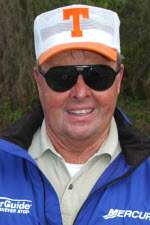
Someone once said that a picture is worth a thousand words, but when you are trying to imagine what underwater structure looks like, a picture may be worth 10,000 words. The only way to capture the picture is to drop marker buoys in a pattern designed to trace out the structure. It’s going to take a little time to do it right and it may require a dozen marker buoys or more, but it also could lead to the largest stringer of bass you have ever taken.
I believe it is worth the extra effort to catch fish. When you have planned and plotted your search for bass and are successful, it is the greatest feeling in the world. There is nothing comparable with finding something you cannot see.
It goes without saying that you must carry a good supply of buoys aboard your boat. I prefer to carry mine in two distinct colors so that I can mark either side of a channel or deep and shallow water. You can fashion your own buoys in a variety of ways. A piece of Styrofoam with some line wrapped around it and a weight works just fine. Buoys are also available commercially and can be purchased individually or in kits of a half dozen or more.
Dropping buoys is pretty much a matter of common sense. Your goal is to outline the structure so that you can find the exact location of a dropoff or follow a curve or bend in a creek channel. In buoying a dropoff you must work the boat back and forth, using your depthfinder to select each point where water depth begins to drop. Start in one corner and follow an in-and-out path, tracing the entire point. If you find that one area has a particularly sharp drop-off or some irregular feature, you can use a different-colored buoy to mark it.
Once you have finished dropping the buoys, the underwater picture begins to come into focus. The best approach is to take out your notebook and sketch the outline of the structure, using reference points where possible to orient it.
After you have recorded your find, you are ready to fish it, and you will discover that the buoy system will guide each cast and help you to cover the area thoroughly. When you have fished the spot completely, ease through it again and retrieve your buoys.
When you are marking a creek channel, use two separate colors to denote each side of the creek, and follow the bends in the creek carefully. If you drop buoys at closer intervals, you will trace a better outline. As you become more experienced, you won’t need as many buoys to tell you how the creek meanders.
An underwater ridge can be fished by sitting over deeper water and casting into shallower water or by sitting over the ridge and working your lure from deep to shallow. A third option is to sit off one of the points and cast parallel to it. No matter how you plan to fish it, your buoys should mark both ends of the ridge and both sides.
A hump should be buoyed on all sides, and the number of buoys again depends on the area involved. Don’t skimp when you drop buoys. It is better to have an extra one or two than to be confused on the structure shape. The side of the hump closest to the deeper water will be the best bet, and you might want to mark these buoys with a different color.
Don’t fall into the trap of laziness. It is easy to convince yourself that you don’t have to mark out a new spot before fishing it, but you must also accept the risk of not fishing it properly.
For more words of wit and wisdom from one of our sport’s greatest legends, check out www.billdanceoutdoors.com.

